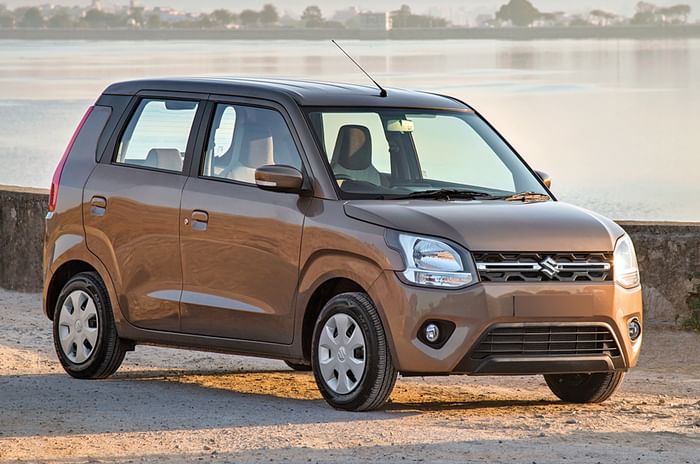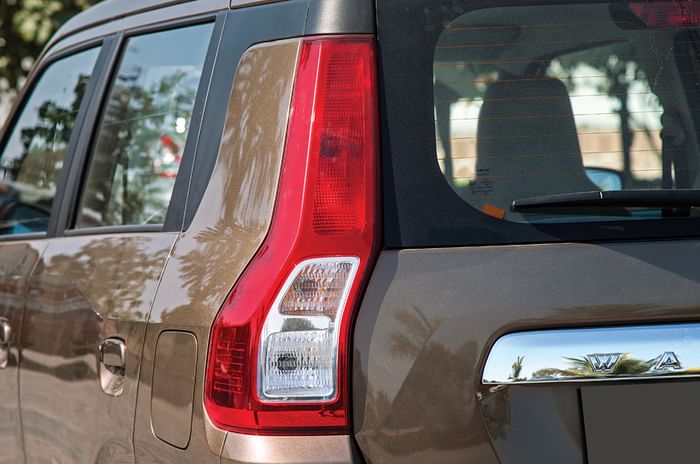The small Maruti Suzuki Wagon R is a big deal in India. In two generations, it’s sold over 2.2 million units and is a fixture on India’s top sellers’ list. This third-generation Maruti Suzuki Wagon R you see here exists nowhere else in the world. There are other Wagon Rs, like the one sold in Japan, but for India, Maruti has engineered and built a car that is all but bespoke, tailored specifically for our regulations, conditions and customer needs.
Like most of its sister cars – the Swift, Baleno, Ignis and Ciaz – the new Wagon R is also based on the Suzuki's latest Heartect platform. The old Wagon Rs were built on the smaller A platform that underpins Suzuki’s line of ‘kei’ compact hatchbacks for Japan. Benefits of the new platform include improved performance in crash tests, a lighter kerb weight, improved dynamics and an even roomier cabin.

The old Wagon R’s 68hp, 1.0-litre three-cylinder K10 unit has been carrier over but it’s been tweaked for more economy (22.5kpl, ARAI figure). The bigger news is that, for the very first time, the Wagon R is also available with Suzuki’s larger 1.2-litre, four-cylinder K12 engine. The option of the 83hp engine, Maruti insiders say, is in response to the demands of Wagon R loyalists who felt the car needed more zing. Of course, fuel economy hasn’t been sidelined on the 1.2 either. Its ARAI-tested 21.5kpl is among the best in segment. Both engines are available with 5-speed manual and AMT gearboxes.

The Wagon R 1.0’s prices start at Rs 4.19 lakh for the LXi trim, while Wagon R 1.2’s prices start at Rs 4.89 lakh for the VXi (ex-showroom, Delhi). Do note, the price difference between the same trim of both engine versions stands at Rs 20,000 only.
What’s it like on the outside?
The third-gen Wagon R retains the tall-boy proportions of its predecessors but also looks like a more substantial car. That’s because it is. Compared to the outgoing model, the new Maruti Suzuki Wagon R is 56mm longer, a substantial 125mm wider and is 35mm longer in its wheelbase too. The number that’s gone down is for weight. Spec-for-spec the new Wagon R 1.0 is 65kg lighter than its predecessor, and even the heaviest of the Wagon Rs, the 1.2 ZXI AGS, tips the scale at just 845kg.
The third-gen Wagon R does have a bit more style to it. There’s a bulkier and more rounded-off nose, and elements – like the 'arrow'-shaped headlights and the sporty chin – look good. It’s not slab-sided either. There’s a nicely sculpted shoulder line and neatly defined wheel arches, and even the glass house is clearly 'in-set' from the base of the car. The black plaque that runs from the C-pillar to the tailgate gives the Wagon R a 'floating roof' look and even the big Honda CR-V-like tail-lights work well.
Not so nice, albeit acceptable on a car of this class, are the Wagon R’s lift-type door handles. Alloy wheels too are available only as an accessory, and if you look closely, you’ll notice there’s no cladding in the wheel wells. The bonnet shut line is not the tightest either but Maruti says that’s been done deliberately to minimise the possibility of damage to the upper portion of the plastic grille in the event of the bonnet being slammed shut.
What's it like inside?
As ever, ingress-egress is very convenient on the Wagon R and you get a great view out of the cabin too. The first impression of what’s inside the cabin is also very positive. The cabin looks better appointed and the two-tone black-and-beige theme works well. Also helping the look is the new instrument cluster that, on higher variants, features an integrated digital tachometer. The presence of the Ignis’ steering wheel lifts the quality quotient even further. No, there are no soft-touch bits, but the nicely textured top of the dash makes it feel more upmarket than before and even the door pads are a bit better-finished.
The design of the dash, however, is not very impressive. It is disproportionate, the fascia is slab-like and even the centre console is placed at a jaunty angle, which further adds to the visual dissonance. Then there are the odd-looking vents and plenty of bits carried over – like the window-winder buttons. Also, the new front seats, though larger, are quite flat and featureless; which means that you don't so much as sink into them as sit on them. The fixed front headrests also restrict frontal visibility for rear seat occupants.
What you will appreciate is how much wider the new Wagon R’s cabin is. The driver and passenger don't sit shoulder-to-shoulder as in older Wagon Rs and the wider cabin also allows three to sit in more comfort than previously possible on the bench-like rear seat. The legroom has also increased and the headroom is, expectantly, plentiful too. What’s a shame is that Maruti has given adjustable rear headrests a miss. The fixed rear headrests are not only small for adult of average height but are also angled in a way that they poke into an occupant’s upper back.
Practicality has always been a Maruti Suzuki Wagon R’s strong suite, and the new model only improves in this area. Boot space has doubled to 341 litres, and the long, wide and deep boot can hold plenty of luggage. On all but the base versions, the seats split 60:40 for even greater practicality. Even inside the cabin, you’ll find a larger glovebox, sizeable door pockets up front and useable pockets on the rear doors. Although, the little cubby hole above the gear lever isn't very practical. It's small, and since there's no rubberised mat, your odds and ends keep sliding around. And given how integral your smartphone is to the entertainment suite, you’ll miss a dedicated slot to place your mobile.
The new Wagon R is among the first models to feature Maruti’s new SmartPlay Studio infotainment system. At 7.0-inches, the new unit’s screen is no larger than the older SmartPlay system’s but usability is much improved, with better touch responses and larger ‘tabs’ for frequently accessed functions. Android Auto and Apple CarPlay are part of the package, and the system can also use a paired device’s internet to stream online music, access news and get weather updates. You can even control the audio system wirelessly via a smartphone app. Neat. Among the other firsts on the Wagon R are steering-mounted buttons for the infotainment system, while a driver’s side airbag (dual airbags on top-spec versions), rear parking sensors and anti-lock brakes are standard across the range, in line with upcoming safety requirements.
What's it like to drive?
We got our first taste of the Wagon R in the more powerful of its two avatars. We’ve already experienced the 83hp, 1.2-litre engine on the Ignis, Baleno, Swift and Dzire and know it as a peppy and refined unit. However, the engine adds a whole new dimension of performance to the lightweight Wagon R.
Compared to the modest responses of the old Wagon R’s 1.0 engine, the new Wagon R’s 1.2 feels alert and light on its feet at all times. It picks up speed effortlessly and makes for a very pleasant drive as there is plenty of go in the mid-range. You can feel the added pulling power and even when driving in a higher gear for a given speed, the Wagon R doesn’t feel lifeless. In fact, there’s a newfound sportiness to the way the Wagon R drives. The engine likes to be revved, and performance gets stronger and stronger as you go up the power-band.
We strapped on our trusty VBox to see just how much faster the Wagon R is, and the numbers are telling. Where the old 1.0 did 20-80kph in third in 15.69sec, the new 1.2-litre model takes 12.67sec. 40-100kph in fourth gear is also quicker, at 18.38sec, versus the old 1.0’s leisurely 23.56sec. In fact, the timings make the Wagon R significantly quicker than the Hyundai Santro, Datsun Go, Tata Tiago and even Maruti’s own Celerio.
And if only for academic interest, we even did a full-bore acceleration run. The new Wagon R’s 11.98sec time is nearly 5.0sec down on the old car’s time! Using all the revs in the lower gears whips the tiny front wheels into a frenzy. Once the wheels grip, the Wagon R shoots forward with a never-before-experienced sense of purpose. Get this – the new Wagon R with the 1.2-litre engine has a power-to-weight ratio of nearly 100hp per ton! Is it any wonder?
However, when you visit the top end of the power band, between 5,000-6,500rpm, the Wagon R does get noisy. You can tell that this car doesn’t have much by way of sound insulation. And if you stop and think about it, the additional performance feels like a bit of an overkill, as the new Wagon R often seems to get overwhelmed by all the power. We wish the manual gearbox were a bit better, too. It's light and easy for the most part but occasionally you also need that second push to slot gears in.
Urban buyers will take keenly to the AMT automatic version. The 5-speed AMT still doesn’t have the smoothness of a torque converter but the head nod AMTs are notorious for is largely restricted to shifts between first and second gears. Things smoothen out in the higher gears and the gearbox certainly doesn’t seem like a compromise. What’s also nice is how responsive the gearbox is to manual inputs. The Tiptronic function is quite slick and comes handy when you want to take charge or when you want to maximise engine braking on a descent. Speaking of which, you’ll need to make judicious use of the handbrake on hill starts. The car has a tendency to roll back before the gearbox ‘engages’. Performance-wise, our preliminary tests reveal a big jump over the old Wagon R 1.0 AMT. 0-100kph comes up in 13.28 seconds (vs the old car’s 17.23secs), 20-80kph takes 8.22sec (vs 10.89sec) while 40-100kph comes up in 9.58sec (vs 12.70sec).
On its wider track and stiffer Heartect floorpan, the Wagon R’s stability in a straight line has improved. That said, the Wagon R still doesn’t take readily to direction changes at high speeds and the bluff shape and light weight also make it susceptible to moving about in strong gusts of wind. The light and lifeless steering won’t do much for confidence at high speeds either. Frankly, the Wagon R works best as a city car. Drive it in town and you’ll notice ride quality is quite good. It's no longer choppy, to begin with, large bumps can be ridden over without the car being tossed around excessively and the suspension also works a bit more silently than before. Even cabin insulation is marginally better. However, because of the light build, a fair amount of road and suspension noise still does filter in.
Should you buy one?
Larger on the inside, now available with a more powerful engine, better-equipped and better-built, the new Wagon R has a lot to offer. It’s fairly well-priced too. Remember that this is not a car to buy if you enjoy driving, and its appliance-like character won’t appeal to enthusiasts either. What the Wagon R does is retain its original formula of an incredibly functional budget car. For spaciousness and sheer practicality, the new Maruti Suzuki Wagon R is still the car to beat.
Also see:





